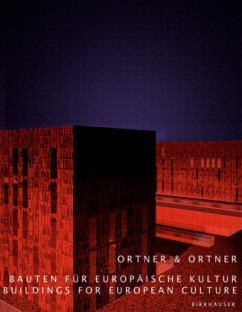Das Anknüpfen an Traditionen ist keine Rückwärtswendung, sondern verleiht einer gemeinsamen Identität neue Dynamik – diese Nachricht sollen die Bauten aus dem österreichischen Architekturbüro Ortner & Ortner vermitteln. Europäische Kultur wird dabei als exemplarische Situation verstanden, in der sich Altes und Neues besonders facettenreich miteinander vereint.
Mit dem Museumsquartier Wien, dem Schiffbau Zürich und der Bibliothek Dresden stellt das Buch drei aktuelle und international bedeutsame Kulturbauten ins Zentrum der Aufmerksamkeit. Ergänzt werden diese von etwa 20 weiteren Bauprojekten aus den Kategorien Theater, Museum und Bibliothek, die, beginnend mit den frühen Pavillonbauten aus der Haus-Rucker-Co Zeit (1967–1992), die Thematik "Architektur für Europäische Kultur" aufgreifen. Ein umfassender Textteil mit Beiträgen von Bart Lootsma, Ernst Hubeli und Sophie Lovell versucht die Mixtur aus europäischer Architektur zu ergründen und rundet die Gesamterscheinung des Buches ab.
Incorporating tradition doesn’t mean turning back the clock, but infusing a common identity with new dynamism. This is the message the Austrian architectural firm Ortner & Ortner seeks to convey with its buildings. They see European culture as an exemplary situation, in which old and new combine to create a particularly rich and multifaceted mix.
With Vienna’s museum district, Zurich’s Schiffbau arts complex, and the Dresden Public Library, this book focuses on three internationally significant contemporary cultural buildings. These are supplemented by some twenty additional building projects from the categories of theater, museum, and library, all of which – beginning with the early pavilion buildings from the Haus-Rucker-Co era (1967–1992) – take up the subject of "architecture for European culture." A large text section with essays by Bart Lootsma, Ernst Hubeli, and Sophie Lovell attempts to get to the bottom of this special mix of European architectures and rounds off the book as a whole.
Mit dem Museumsquartier Wien, dem Schiffbau Zürich und der Bibliothek Dresden stellt das Buch drei aktuelle und international bedeutsame Kulturbauten ins Zentrum der Aufmerksamkeit. Ergänzt werden diese von etwa 20 weiteren Bauprojekten aus den Kategorien Theater, Museum und Bibliothek, die, beginnend mit den frühen Pavillonbauten aus der Haus-Rucker-Co Zeit (1967–1992), die Thematik "Architektur für Europäische Kultur" aufgreifen. Ein umfassender Textteil mit Beiträgen von Bart Lootsma, Ernst Hubeli und Sophie Lovell versucht die Mixtur aus europäischer Architektur zu ergründen und rundet die Gesamterscheinung des Buches ab.
Incorporating tradition doesn’t mean turning back the clock, but infusing a common identity with new dynamism. This is the message the Austrian architectural firm Ortner & Ortner seeks to convey with its buildings. They see European culture as an exemplary situation, in which old and new combine to create a particularly rich and multifaceted mix.
With Vienna’s museum district, Zurich’s Schiffbau arts complex, and the Dresden Public Library, this book focuses on three internationally significant contemporary cultural buildings. These are supplemented by some twenty additional building projects from the categories of theater, museum, and library, all of which – beginning with the early pavilion buildings from the Haus-Rucker-Co era (1967–1992) – take up the subject of "architecture for European culture." A large text section with essays by Bart Lootsma, Ernst Hubeli, and Sophie Lovell attempts to get to the bottom of this special mix of European architectures and rounds off the book as a whole.

